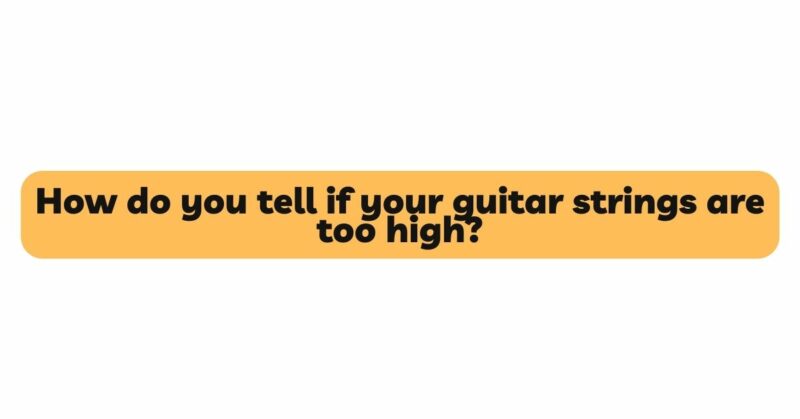The guitar, a timeless instrument cherished for its versatility and ability to evoke emotions through its melodies, is a cherished companion for musicians around the world. However, like any finely crafted tool, the guitar requires regular attention to maintain its optimal playability and sound quality. One common issue that guitarists encounter is high string action – a condition that can impede their playing and hinder the instrument’s overall performance. In this article, we delve into the intricacies of high guitar string action, exploring how to recognize its signs, its impact on playability and sound, and the steps you can take to address this concern and restore your guitar’s ideal setup.
Understanding High Guitar String Action: Guitar string action refers to the distance between the strings and the fretboard. When this distance becomes excessive, the guitar is said to have high string action. Proper string action is crucial for ensuring comfortable playability, intonation accuracy, and tonal clarity. However, high string action can introduce a range of challenges that affect a guitarist’s experience.
Spotting the Signs of High String Action: Recognizing the signs of high guitar string action is pivotal for diagnosing the issue and taking appropriate action. Here are some telltale signs that your guitar strings might be too high:
- Difficult Fretting: One of the most noticeable indicators is the difficulty in fretting notes and chords. If you find yourself needing excessive finger pressure to press down the strings, it’s a strong indication that the strings are positioned too high above the fretboard.
- Unwanted Buzzing: High string action can lead to buzzing sounds when you play certain notes or chords. This buzzing occurs because the strings are too far from the frets, allowing them to vibrate against the frets unintentionally.
- Limited Bending and Vibrato: The elevated strings can hinder your ability to perform bending and vibrato techniques effectively. Bending strings requires bending them towards the fretboard, and if the strings are positioned too high, this becomes challenging.
- Inaccurate Intonation: If your guitar’s intonation seems off – meaning that the notes do not play in tune across the fretboard – it could be a result of high string action affecting the strings’ length and tension.
- Reduced Sustain and Volume: High string action can dampen the vibrations of the strings, leading to reduced sustain and volume. This can result in notes fading out quicker than expected and a less vibrant overall sound.
Impact on Playability and Sound: Understanding the implications of high string action on your playing experience and the guitar’s sound quality is essential:
- Playability Challenges: Excessive string height makes playing more physically demanding. The additional finger pressure required to fret notes and chords can lead to fatigue and discomfort during extended playing sessions.
- Intonation Issues: High string action can negatively affect intonation, causing notes to sound out of tune across different frets. This undermines the guitar’s ability to produce harmonically accurate melodies.
- Limited Expressiveness: Techniques like bending, vibrato, and hammer-ons become less responsive and fluid due to the increased distance between the strings and the fretboard.
- Tonality and Resonance: The strings’ distance from the fretboard affects their ability to vibrate freely. High string action can dampen the strings’ movement, leading to reduced sustain and altered tonal characteristics.
Diagnosing and Addressing High String Action: Correcting high string action involves a systematic approach to identifying the causes and making the necessary adjustments. Here’s how you can diagnose and address the issue:
- Visual Inspection: Observe the gap between the strings and the fretboard. If the gap appears too large, it’s an indication of high string action.
- Fretting Test: Play notes across the fretboard and assess the ease of fretting. If you encounter resistance or find it challenging to press the strings down, the action might be too high.
- Buzzing Assessment: Listen for buzzing sounds when playing chords and individual notes. Buzzing indicates that the strings are making contact with the frets due to high action.
- Saddle and Nut Evaluation: Examine the bridge saddle and nut. If they appear excessively high, they might be contributing to the high string action.
- Professional Consultation: If you’re unsure about diagnosing or addressing high string action, consult a qualified guitar technician. They have the expertise to assess the issue accurately and make precise adjustments.
Seeking Professional Expertise: While addressing high string action can be attempted through DIY adjustments, seeking the expertise of a professional guitar technician is recommended. A skilled technician can accurately diagnose the issue, recommend appropriate modifications, and ensure adjustments are carried out safely and effectively.
Conclusion: High guitar string action need not deter you from enjoying the pleasures of playing your instrument to its fullest potential. By recognizing the signs of high string action and understanding its impact on playability and sound, you can take proactive steps to address the issue. Whether you’re a beginner or an experienced guitarist, the journey to achieving the perfect string action is a testament to your dedication to your craft and your commitment to producing music that resonates with precision and emotion. As you embark on this journey, remember that every adjustment you make brings you closer to the harmonious balance between your instrument and your musical aspirations.


